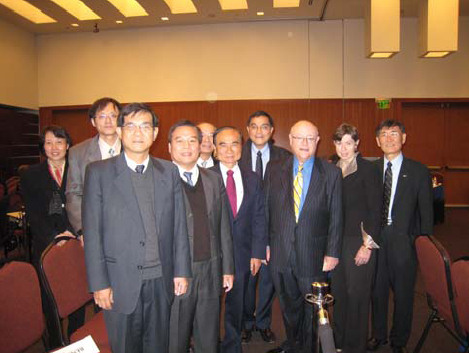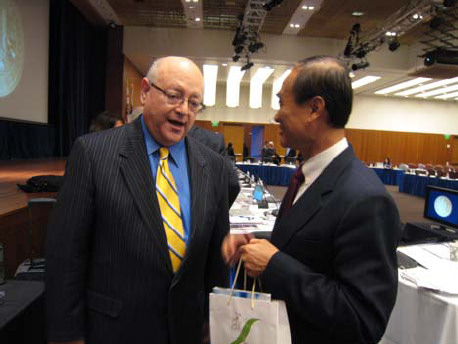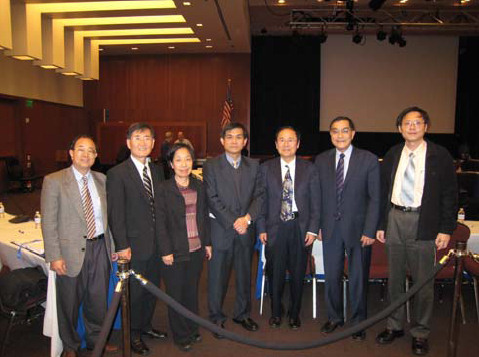A Historical Visit By Taiwan’s T3 System
to University of California Board of Regents Meeting
A Lesson on University System
Da Hsuan Feng 馮達旋
Senior Executive Vice President
National Cheng Kung University

A Group Photo at the meeting. The gentleman next to President Lai is President Mark Yudof of UC System. Next to him is Chancellor Fox of UCSD and next to her is Chancellor Kang of UC Merced

President Mark Yudof of UC System and President Lai of NCKU talked about the issues facing UC at the moment
On March 23-25, 2010, a higher education delegation from Taiwan, whose members are:
- President Michael Lai(賴明詔)of National Cheng Kung University(NCKU,)
- President Jei-Fu Shaw(蕭介夫)of National Chung Hsing University(NCHU,)
- President Hung-Duen Yang(楊弘敦,)President of National Sun Yat-Sen University(NSYSU)
- Senior Executive Vice President Da Hsuan Feng(馮達旋)of NCKU
- Vice President Yung-Sheng Huang(黃永勝)of NCHU
- Vice President Kin-Lu Wong(翁金輅)of NSYSU
- Chairman of Chemical Engineering Ching-Chen Chen(陳進成)of NCKU
attended the University of California Board of Regents meeting. Themeeting venue was UC San Francisco Mission Bay campus. Every member of our delegation was profoundly honored by the invitation, especially when we were treated so “royally!”
Why this visit?
For the past several years, three universities in the middle and southern part of Taiwan, National Cheng Kung University(國立成功大學)National Chung Hsing University(國立中興大學)and National Sun Yat-Sen University(國立中山大學)were incubating and proactively developing the concept of forming a “system,” known as T3. One important efforts of this development the leaderships of these institutions undertook was to seek the experiences of some well known and well established “system” in the world. To this end, the University of California System was chosen as a target to study.
Why did we pick UC System?
Overall speaking, the concept of “University System” in the United States(in this report, I will concentrate only on research universities)began in the mid-19th century. Many systems are now well organized in a number of States. Some of the notable ones are
- New York(SUNY System)
- Pennsylvania(Pennsylvania State System of Higher Education)
- Texas(University of Texas System, Texas A and M University System, University of North Texas System, University of Houston System, and so on)
- Wisconsin(University of Wisconsin System)
and of course
- California(University of California System, Cal State University System, and so on)
With more than a century of practice, it is no wonder that the concept of putting many “public” universities in a State together to form a “system” in the United States has become what the Chinese would refer to as 根深蒂固, or “deep roots and rigid stems,” with significant number of “kinks” shaken out.
While there is no official ranking of which system, there is a common understanding the University of California System is regarded as one of the best, if not the best.
For the T3 leadership, there are at least five reasons for our choice.
- First, in the United States, there is a higher education “elite club” for research, or doctoral granting, universities known as American Association of Universities, or AAU. AAU was founded in 1900. Today, it is commonly regarded that only the best research universities in United States and Canada are inducted into the club. For example, for Texas, New York, Pennsylvania and Wisconsin, each with no more than two AAU members:University of Texas at Austin(inducted in 1929,)Texas A and M University(2001,)Buffalo(1989,)Stony Brook(2001,)Penn State U(1958,)University of Pittsburgh(1974)and University of Wisconsin Madison(1900,)California has six(or 10% of the total number.)They are Berkeley(1900, one of the three public universities which is a founding member,)UCLA(1974,)UCSD(1982,)UCSB(1995,)UCDavis(1996,)and UCIrvine(1996.)
- Second, a measurement of academic excellence is National Academy of Sciences(NAS)membership. For example, for Berkeley and UCSD, there are 136 and 85 members, respectively. Even for UCSB, which is a much smaller campus as compared to Berkeley and UCSD, it has 23 members. It is interesting to note that the numbers of Berkeley and UCSD are significantly higher than the total number of NAS members for the entire of State of Texas, which is 54! Interesting to note that there is now an active movement in Texas to change this scenario.
- Third, the current structure of the University of California System is directly linked to the world renowned “California Higher Education Master Plan,” which was the brainchild of Clark Kerr, President of the University of California System fifty years ago(1960.)It is probably not an exaggeration to say that it is the farsighted vision of the Master Plan that gave rise to such an outstanding research university system.
- Fourth, as the old saying goes, “when the going gets tough, the tough gets going!” This means that the best time to learn the functioning of a system is when it is in a stressed mode, and not necessarily when it is in a relaxed mode. To this end, the time to learn about UC System is now. As is now well known, the State of California is facing the most severe financial difficulty. In addition, quite by serendipity, in recent weeks, there were a number of unfortunate and ugly incidents on various UC campuses, thus placing even more stress on the System. For us, we consider this a great opportunity to observe how the UC System faces and deals with this era of great difficulty. It is time like this the true characters of the System will be revealed and an extremely worthy lesson which in our opinion no money can buy!
- Fifth, without some luck, while we may have the desire to choose UC System as a target, UC System may not allow us to do so without some credible reasons. To this end, we were extremely fortunate that in NCKU’s Presidential Blue Ribbon Panel to learn about higher education autonomy, two of its world renowned members, Dr. Steve Kang and Ms. Leslie Tang Schilling are the Chancellor of UC Merced(the newest campus of the 10 UC campuses)and a member of UC Board of Regents, respectively. It was through the hard work of these two individuals that we were invited by President Mark Yudof of UC System to attend its Board of Regents Meeting on March 24 – 25, 2010.
It is worth noting that the group had another truly lucky moment at the meeting on the second day. Normally, at the Board of Regents meeting, with full program agendas, there would be little time for us to have in depth conversations with the Regents as well as the Chancellors. However, for nearly an hour and a half on the second day morning, the Regents had a “close session” in which all the Chancellors as well as the senior members of the System were not allowed to attend. While they were all loittering in the hall way, where we were as well, we leveraged this “down time” for them to engage in many very useful one-on-one conversations. What we learned again could not easily be obtained from the formal meeting!
A group photo with Chancellor Katehi of UC Davis and Chancellor Kang

A group photo with Chancellor Yang of UC Santa Barbara and Chancellor and Mrs. Kang
Our mission
We have two surgical reasons for coming to this Board meeting.
First, as was mentioned, NCKU which is in Tainan, NCHU which is in Taichung and NSYSU which is in Kaohsiung are in the process of organizing themselves to become a university system known as T3. To design the roadmap, from conception to reality(hence a “system”,)it is necessary for some serious homework. To this end, we need to gather information and observe first hand how the campuses within the UC System interact and compete with one another, how the ten campuses interact with the Board of Regents, and how the Board of Regents interact with the ten universities communities as well as the State Government in Sacramento. These would be extremely valuable lessons-learned of the system framework as our three universities strive to improve our educational qualities by becoming a system. With Asia developing at such a fast pace, higher education quality is becoming a more and more critical and imminent challenge for the entire region.
Second, all national universities in Taiwan, for which there are some 70, in principle and in practice “report” directly to the Ministry of Education. All the so-called “research universities,” for which NCKU, NCHU and NSYSU are classified as such, report to the Division of Higher Education within the Ministry. Such a raw relationship can easily create significant room for improvement. It is interesting that in our conversation with Chancellor Katehi, she mentioned that her home country, Greece, also faces the same challenge as Taiwan. This is why as representatives of the T3 universities, we are here to observe how the “intermediate level” between the “government,” in California’s case, the State Government in Sacramento, and the “universities,” in this case, the ten UC campuses, operates. This intermediate level is known as the Board of Regents. Through the discussions with many senior members of the System Office, and through discussions with a number of Board Members, we were given in depth and first hand knowledge of how the Board functions. We believe that no amount of reading relevant documents will give us such valuable knowledge.
Who did we meet in the two days
In the two days, we were honored to meet with the following 18 individuals.
- Dr. Mark Yudof, President of the University of California System.
- Chancellor Sung-Mo "Steve" Kang, University of California Merced
- Chancellor George R. Blumenthal, University of California Santa Cruz
- Chancellor Robert J. Birgeneau, University of California Berkeley
- Chancellor Timothy P. White, University of California Riverside
- Chancellor Linda P. B. Katehi, University of California Davis
- Chancellor Michael Drake, University of California Irvine
- Chancellor Marye Anne Fox, University of California San Diego
- Chancellor Henry T. Yang, University of California Santa Barbara
- Chancellor Susan Desmond-Hellmann, University of California San Francisco
- Dr. Lawrence Pitts, M.D., Interim Provost and Executive Vice President Academic Affairs, University of California System
- Bruce B. Darling, Executive Vice President, University of California System
- Marie N. Berggren, Chief Investment Officer, Vice President for Investments and Acting Treasurer, University of California System
- William De La Pena, M.D., Regent of the University of California
- Leslie Tang Schilling, Regent of the University of California
- Dr. Judy K. Sakaki, Vice President for Students Affairs, University of California System
- Charles F. Robinson, Vice President and General Counsel, University of California System
- Dr. Steven V. W. Beckwith, Vice President for Research and Graduate Studies, University of California System.
What did we learned?
We learned a great deal from one-to-one discussions with the Administrators and the Chancellors. The discussion with Dr. Pitts, the interim Provost and Executive VPAA was illuminating and information rich. As the second highest official in UC System, who obviously knows the System inside-out. The System is a very busy body, meeting six times a year, and each time is for two full days of agendas. In between the meetings, there could also be committee meetings. Since most Board members belong to no more than three committees, it is likely that each could average out to something like 7 to 8 meetings per year. Just as the United States Congress, no votes by the Regents can be casted by proxy or by “designated representatives!” This means that any one who is not totally devoted to the well being of UC probably would not want to be a part of this august body. Dr. Pitts gave us many details of the structure of the Board which we did not know. One of the most important information he told us is that the UC Board of Regents is legal stature wise the “fourth branch of the State Government,” with equal stature with the State Administration(led by the Governor,)the Legislation(the State House of Representatives,)and Judiciary(the State legal structure.)He also gave us many details as to how one could diminish the “political influence” of the Board. These are truly valuable lessons for us. I did asked several of the Chancellors what would be the scenario like if there were no Board of Regents and that the universities have to deal directly with the State Government, and all said that this would be a “formula for disaster!” One interesting note from one of the Chancellors is that he is not convinced that having ONE Board for all ten campuses is necessarily the best model for us to emulate. “If I could redesign it,” said this Chancellor, “I would have a Board for each campus.”
A very important point for all the Regents is that they serve on the pro-bono basis!
A very interesting thing we learned is that the two faculty representatives on the Board are NON-VOTING members. Apparently this was the choice of the Faculty Senate of the ten campuses, not the decision of the UC System. The rationale is that if the faculty members can vote, then they could be perceived as having conflict of interest. However, we were assured that there is no consensus from the Faculty Senate about this, and the NON-VOTING stature could be changed by the faculty. At the moment, it is NON-VOTING.
There is one member of the Board who is a student. We understand that the student is selected from a very complex and comprehensive system from the ten campuses. From listening to the student’s comments during the meeting, I would not have come to the conclusion that he is at most a factor of 2 to 2.5 in age from the other Regents. I found his comments very sophisticated, well thought out, and presented with clear articulation. From talking to Dr. Pitts, I understand that the UC System actually provides an office with staff members for this Regent during the year he/she serves as a member. I also learned from talking to another student that it is quite often the Student-Regent will suffer academically that year and may delay his/her graduation by a year. But imagine the benefit he/she gets by serving on the same par with so many movers and shakers of the State at such a young age!
The presentation by Mr. Darling and his team about the intricate relations between University of California and the three national laboratories, Lawrence Berkeley National Laboratory(LBNL,)Lawrence Livermore National Laboratory(LLNL,)and Los Alamos National Laboratory(LANL)was truly eye opening. LANL and LLNL are known to be weapons laboratory and LBNL is engaging in fundamental research. Darling’s presentation made us recognized the fundamental importance of these world class national laboratories impact on the University of California’s intellectual vitality on the one hand, and on the other, how the universities with students and outstanding faculty enhance the robustness of the laboratories. I do not believe that there is anything of this nature in Taiwan and that this could be a case study for T3 as a System.
I was especially impressed with my(unfortunately short)discussion with Charles Robinson about the legal team of UC. It is clear that a massive system such as UC(with nearly 200,000 students and 100,000 staff and faculty)with all possible human problems, conflicts and complications, there must be enormous number of legal challenges. So it is not surprising that UC would have to have, and does have, a powerful legal team. This to all of us, is the “price” one pays for existing in a democratic system with strong and complex legal structures. In Taiwan, while it is a democratic system, this aspect within the university structure is sorely in need of beefing up. With us making contact with Mr. Robinson, we hope down the road we can interact with him so we can learn more about the intricacies of his office.
We undoubtedly came at the right moment! With some of the highly undesirable and unfortunate events taken place at some of the UC campuses in the past few weeks, we saw first hand how the Board interacted with the public with dignity, elegance and without condescending.
We also saw how University of California, even faced with unprecedented difficult financial situations the State is experiencing, still is able to expand carefully to serve the public. The support of the Regents of the nurturing and expansion of a new campus in the underserved area of California, i.e. UC Merced, is a clear case of foresight and vision.
We saw how the UC system struggles with the issue of “excellence with diversity.” This is one issue where we saw disagreement between Regents. While this is currently not an issue of Asian universities, in time and in foreseeable future, because of the massive movement of humanity in the region and thus creating more complex societies, it could be. For this reason, we look forward to learning how the UC devise a system to meet the challenges of this issue.
Ultimately, we felt that what we sensed in the two days of meeting was that the “immortal” CALIFORNIA HIGHER EDUCATION MASTER PLAN developed exactly 50 years ago was still lurking in many of the discussions.(http://www.ucop.edu/acadinit/mastplan/mp.htm)This reaffirms the age old wisdom that if you begin with a great initial condition, whether it be a MASTER PLAN for higher education or a US Constitution for a nation, it makes outstanding development later on possible, even in tough times. This is an important lesson-learned for us.
Summary
It goes without saying that if one wants to learn a skill, finding the best to learn from is a must. Since “devils in the details,” we were able to have a glimpse of the complex structure of UC System. What is most important is that we have established personal links to these important individuals in the UC System and therefore down-the-road we could request for additional insights and information.
All of us, I am confident, left California a little wiser!





















